Würzburg or Wuerzburg (and sometimes misspelled as Wurzburg) is in Franconia, in northern Bavaria, Germany. It is the largest city in the Lower Franconia region, famous throughout Germany for its wine and as the northern end of the Romantic Road.
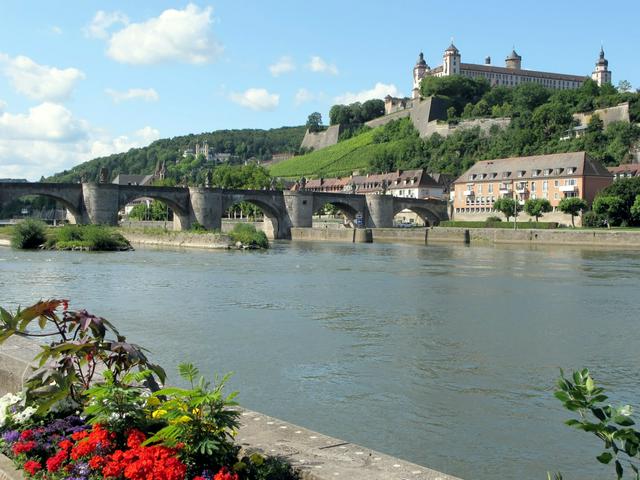
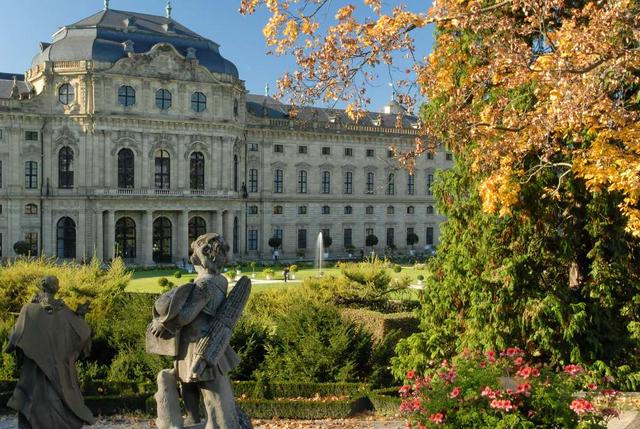
A city rich in history that revolves around the Franconian locality, today Würzburg is a beautiful, historic, and lively city that is often overlooked by foreign visitors. It should also not be overlooked however, that a third of its roughly 130,000 inhabitants are students of 3 colleges based here. As such, travelers can also find an extensive assortment of cheap non-German food and some partying scenes, amidst the local culture the city still preserves.
Founded in the 10th century, Würzburg served as the home of powerful prince-bishops for many centuries. It is renowned for the Residence, regarded as one of the finest palaces in Europe and a high point of Baroque art (UNESCO cultural world heritage). Würzburg is also home to one of the oldest churches in Germany, built in the 8th century on top of a former pagan shrine. One of its most famous structures, Festung Marienberg, is a fortress which now surrounds the church.
Würzburg was the center of the kingdom known as Franconia, also the namesake region for the northern half of what is now the state of Bavaria. In the 19th century, Napoleon merged Franconia with its southern neighbor Bavaria, by which the city is ruled to this day.
Würzburg experienced heavy demolition during a 20-minute Allied bombing raid in 1945 which destroyed some 80% of its city buildings. Much of the city has since been rebuilt, though not as painstakingly true to its original architecture as some other historic German communities. Anyone eager to visit this town to study its historic architectural structures should be prepared to see its restored buildings placed next to several post-war modernistic houses. Until 2006, Würzburg had been home to a large US military installment after World War II, As a result, many of the locals are still familiar with American customs.
Today, Würzburg is still a beautiful old town, which although still not too famous outside Germany, but offers a charming culture and exterior that entices travelers to explore the region, either as part of the Main River cruise or the Romantic Road excursion.
- Würzburg Tourist Information Office, Marktplatz 9, +49 931 37 23 98. Jan-Mar M-F 10:00-17:00, Sa. 10:00–14:00. Apr, Nov,Dec M-F 10:00–18:00, Sa. 10:00–14:00. May–Oct M-F 10:00-18:00, Sa. 10:00–15:00, Su. & holidays 10:00-14:00. Located at the Falkenhaus next to the Maria Chapel. Also sells tickets for the Romantic Road excursion, a 3-day travel pass, and even a wine pass.
Würzburg Tourist Information Office, Marktplatz 9, +49 931 37 23 98. Jan-Mar M-F 10:00-17:00, Sa. 10:00–14:00. Apr, Nov,Dec M-F 10:00–18:00, Sa. 10:00–14:00. May–Oct M-F 10:00-18:00, Sa. 10:00–15:00, Su. & holidays 10:00-14:00. Located at the Falkenhaus next to the Maria Chapel. Also sells tickets for the Romantic Road excursion, a 3-day travel pass, and even a wine pass.
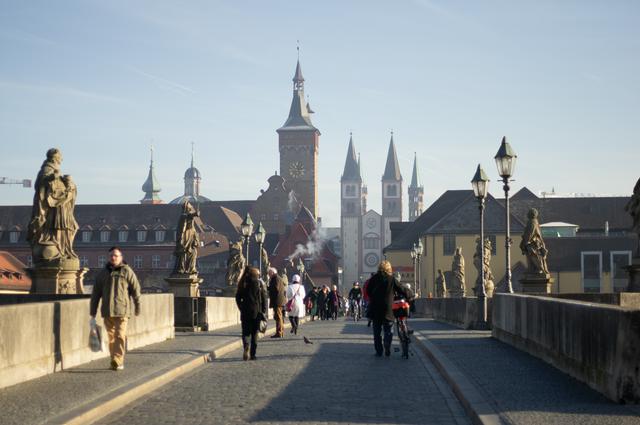
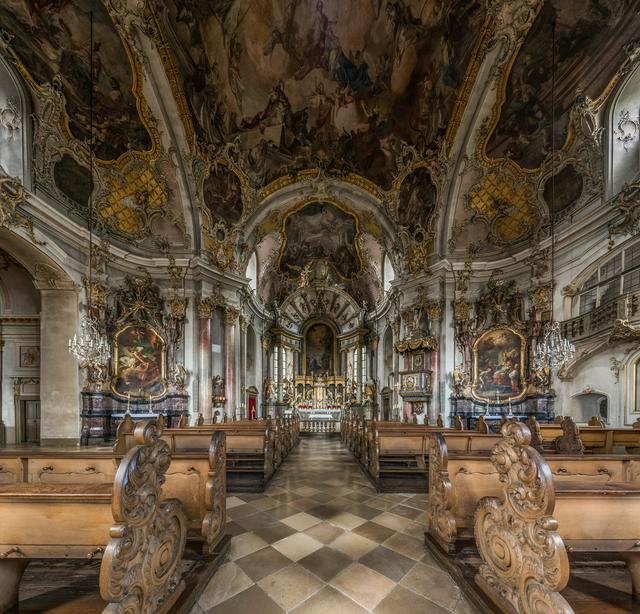 Most of the old history of Wurzburg revolves around the former prince-bishop of the region, who were essentially both the religious and political leaders of the area.
Most of the old history of Wurzburg revolves around the former prince-bishop of the region, who were essentially both the religious and political leaders of the area.
- Würzburger Residence, Residenzplatz 2, +49 931 355170. 09:00-16:00 April-October, 10:00-16:30 November-March. The Residenz is one of the finest Palaces in Europe and famous for its grand staircase. It is regarded as one of the finest pieces of Baroque art in the world as such it has been inscribed on the UNESCO World Heritage List. The building was designed by Balthasar Neuman, and the largest Fresco in the world, above the grand Staircase, was painted by Tiepolo The palace has 300 rooms, spread over 3 wings. There is also a Chapel (Hofkirche) also decorated by Tiepolo which is free to enter and well worth a visit. Its gardens are also built with fortification in mind. Guided tours in English are available daily at 11:00 and 15:00, in addition to 13:30 and 16:30 from April to October. Adults €7.50, reduced €6.50. Church and Garden: free.
- Würzburg Court Garden, Residenzplatz 2, +49 931 355170. Daily dawn to dusk or 8PM, whichever is first. A massive 9-hectare garden designed with Rococo style in mind by Johann Prokop Mayer of Bohemia surrounds three sides of the Residenz, although the West Garden was simply designed, due to the death of builder Adam Friedrich. Each garden has its own features: cone-trimmed yews around the south fountain; parterre, portico, and garden sculptures at the east, and what is now a city park at the west.
- Festung Marienberg, +49 931 3551750. Tu-S 9AM-6PM. The former complex of the prince-bishop before the Residenz, it is the highest point of the city by a hundred meters more than the surrounding land. Thus, the long hike to the top is paid off by a view of the entire town so wonderful, even locals still go here frequently. The viewpoint is adjacent to the Prince's Garden The inside court features a keep and church, whose interior is Renaissance with the first touches of Baroque. For somewhere to wind down, there are two restaurants and a free restroom. Guided tours in English are at 3PM weekends and holidays from April to October. Grounds: Free.
- Old Main Bridge. 24 hours. Not unlike Prague's St. Charles Bridge, it is a pedestrian-only bridge with six statues of kings and saints of historic importance for Catholicism in Franconia on each side. Under the bridge are water locks for ship traffic control on the Main, one of German's most important rivers. Locals would stand here admiring the splendid views of the fort and the river, all while sipping their glass of wine or bottle of beer. Free.
- Maschikuli Tower. 11:00-16:30 on Easter Sunday & Monday, May 10, Pentecost Sunday & Monday, August 15 and October 3. The four-storey tower was built in 1724-1729 by Balthasar Neumann to guard the south flank of the Marienberg fortress. Above the three levels for heavy artillery is a platform for riflemen, equipped with normal firing slits and 21 vertical openings angled downwards: these are the "Maschikulis" from which the tower takes its name. On the valley side the tower is decorated with coats of arms of the Prince Bishop Christoph Franz von Hutten dating from 1727, the work of Jakob van der Auvera. Above them is a bust of St Nepomuk.
- Falkenhaus, Marktpl. 9. M-F 10:00-18:00, Sa 10:00-15:00, So 10:00-14:00. Other than the Maria Chapel next to it, the exterior stands out from the rest of the buildings within sight. The curved gables and bright yellow white paint are Rococo decors, a conception from Barbara Meißner in 1751, whose late husband owned the property. It now houses the Tourist Information Office and the City Library. Free.
Würzburger Residence, Residenzplatz 2, +49 931 355170. 09:00-16:00 April-October, 10:00-16:30 November-March. The Residenz is one of the finest Palaces in Europe and famous for its grand staircase. It is regarded as one of the finest pieces of Baroque art in the world as such it has been inscribed on the [[UNESCO World Heritage List]]. The building was designed by Balthasar Neuman, and the largest Fresco in the world, above the grand Staircase, was painted by Tiepolo The palace has 300 rooms, spread over 3 wings. There is also a Chapel (Hofkirche) also decorated by Tiepolo which is free to enter and well worth a visit. Its gardens are also built with fortification in mind. Guided tours in English are available daily at 11:00 and 15:00, in addition to 13:30 and 16:30 from April to October. Adults €7.50, reduced €6.50. Church and Garden: free.
Würzburg Court Garden, Residenzplatz 2, +49 931 355170. Daily dawn to dusk or 8PM, whichever is first. A massive 9-hectare garden designed with Rococo style in mind by Johann Prokop Mayer of Bohemia surrounds three sides of the Residenz, although the West Garden was simply designed, due to the death of builder Adam Friedrich. Each garden has its own features: cone-trimmed yews around the south fountain; parterre, portico, and garden sculptures at the east, and what is now a city park at the west.
Festung Marienberg, +49 931 3551750. Tu-S 9AM-6PM. The former complex of the prince-bishop before the Residenz, it is the highest point of the city by a hundred meters more than the surrounding land. Thus, the long hike to the top is paid off by a view of the entire town so wonderful, even locals still go here frequently. The viewpoint is adjacent to the Prince's Garden The inside court features a keep and church, whose interior is Renaissance with the first touches of Baroque. For somewhere to wind down, there are two restaurants and a free restroom. Guided tours in English are at 3PM weekends and holidays from April to October. Grounds: Free.
Old Main Bridge. 24 hours. Not unlike Prague's St. Charles Bridge, it is a pedestrian-only bridge with six statues of kings and saints of historic importance for Catholicism in Franconia on each side. Under the bridge are water locks for ship traffic control on the Main, one of German's most important rivers. Locals would stand here admiring the splendid views of the fort and the river, all while sipping their glass of wine or bottle of beer. Free.
Maschikuli Tower. 11:00-16:30 on Easter Sunday & Monday, May 10, Pentecost Sunday & Monday, August 15 and October 3. The four-storey tower was built in 1724-1729 by Balthasar Neumann to guard the south flank of the Marienberg fortress. Above the three levels for heavy artillery is a platform for riflemen, equipped with normal firing slits and 21 vertical openings angled downwards: these are the "Maschikulis" from which the tower takes its name. On the valley side the tower is decorated with coats of arms of the Prince Bishop Christoph Franz von Hutten dating from 1727, the work of Jakob van der Auvera. Above them is a bust of St Nepomuk.
Falkenhaus, Marktpl. 9. M-F 10:00-18:00, Sa 10:00-15:00, So 10:00-14:00. Other than the Maria Chapel next to it, the exterior stands out from the rest of the buildings within sight. The curved gables and bright yellow white paint are Rococo decors, a conception from Barbara Meißner in 1751, whose late husband owned the property. It now houses the Tourist Information Office and the City Library. Free.
- Würzburger Dom, Domstraße 40, +49 931 38662900. One of the largest Romanesque's churches in Germany, the Catholic church in its present form was built from 1040 to 1075 and consecrated in 1187. Objects of interest include a 700-year old bronze baptismal font, an expressionist bronze portal, a menorah at the main entrance, and The Schönborn chapel with its fresco.
- Marienkapelle, Markplatz 7, +49 931 38662800. This building essentially dominates the market square, thanks to its size and its dominant red paint. The chapel, erected in 1377, is a mixture between a basilica and a hall church that was popular in the late-Gothic period and its three portals portray late Gothic to early Renaissance design, each with its own delicate carving at its tympanum, depicting of some of the key events of Christianity. A the top of the tower is a gold-covered statue of Mary.
- Käppele, Spittelbergweg 21 (Take bus 35 to Käppele bus stop, walk down a small alley called Johannisweg, +49 931 79407760. Daily 8AM-5PM. A church at the hillside near the fortress. From its humble beginnings as the site of an erected pieta in 1640, at which at least four miracles were reported, a chapel was then built around it. Balthasar Neumann, the same architect that designed the Residence, built a church that incorporated the old chapel in 1750, though the interiors were actually not finished until 71 years later. Because of its extensive collection of life size statues and classy interior, it is an extremely popular place for weddings, in addition to pilgrimage during the Marian holidays and Pentecost.
- Neumünster, +49 931 38662900. Daily 8AM-6:30PM. Mightily standing from the 11th century and now clipped between shops, its narrow pink Romanesque facade gives way to Baroque beauty inside. The white wall is a nice contrast to gold finishes and colorful altar and murals. Something also worth looking is a Madonna from the workshop of Tilman Riemenschneider and the St. Kilian's Crypt.
Würzburger Dom, Domstraße 40, +49 931 38662900. One of the largest Romanesque's churches in Germany, the Catholic church in its present form was built from 1040 to 1075 and consecrated in 1187. Objects of interest include a 700-year old bronze baptismal font, an expressionist bronze portal, a menorah at the main entrance, and The Schönborn chapel with its fresco.
Marienkapelle, Markplatz 7, +49 931 38662800. This building essentially dominates the market square, thanks to its size and its dominant red paint. The chapel, erected in 1377, is a mixture between a basilica and a hall church that was popular in the late-Gothic period and its three portals portray late Gothic to early Renaissance design, each with its own delicate carving at its tympanum, depicting of some of the key events of Christianity. A the top of the tower is a gold-covered statue of Mary.
Käppele, Spittelbergweg 21 (Take bus 35 to Käppele bus stop, walk down a small alley called Johannisweg, +49 931 79407760. Daily 8AM-5PM. A church at the hillside near the fortress. From its humble beginnings as the site of an erected pieta in 1640, at which at least four miracles were reported, a chapel was then built around it. Balthasar Neumann, the same architect that designed the Residence, built a church that incorporated the old chapel in 1750, though the interiors were actually not finished until 71 years later. Because of its extensive collection of life size statues and classy interior, it is an extremely popular place for weddings, in addition to pilgrimage during the Marian holidays and Pentecost.
Neumünster, +49 931 38662900. Daily 8AM-6:30PM. Mightily standing from the 11th century and now clipped between shops, its narrow pink Romanesque facade gives way to Baroque beauty inside. The white wall is a nice contrast to gold finishes and colorful altar and murals. Something also worth looking is a Madonna from the workshop of Tilman Riemenschneider and the St. Kilian's Crypt.
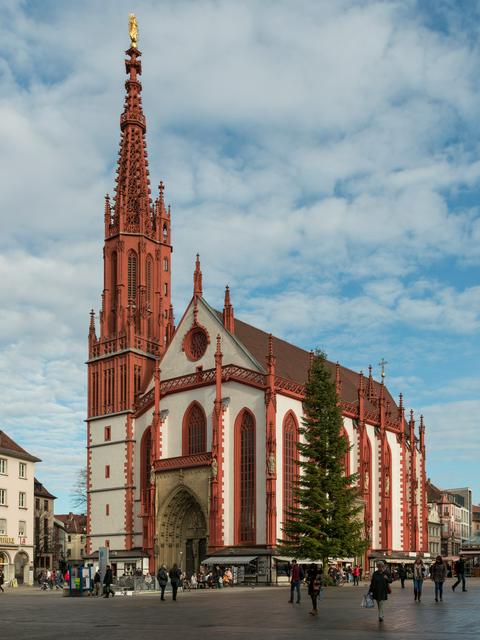
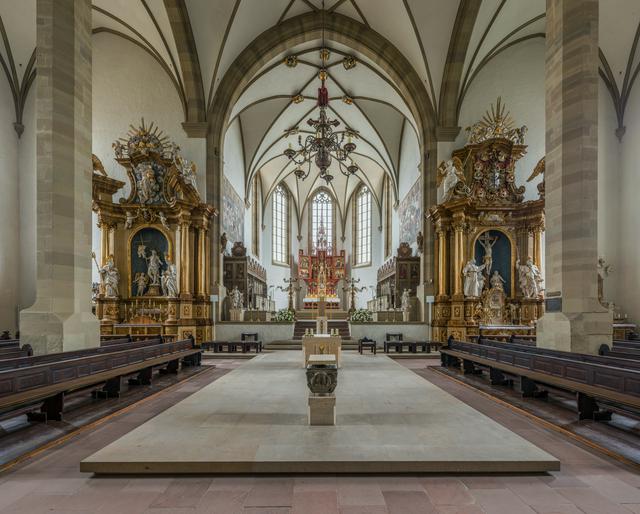
No trip to wine country is complete without touring the cellar and sampling the finest fruit of the vine. Although all tours are by default conducted in German, one can ask questions personally in English and they will be glad to help.
- Juliusspital, Klinikstraße 1, +49 931 393-1400. The largest Franconian wine producer is part of the Juliusspital Foundation, founded in 1576 by Bishop Julius Echter. It is no wonder that their cellar is actually located at the city center, at the grounds of the hospital of the same name. Tours and choice of 3 wine tastings Saturdays at 2PM from March to December. Its diverse portfolio of wines can also be seen at its ownVinothek. Tours 14€.
Juliusspital, Klinikstraße 1, +49 931 393-1400. The largest Franconian wine producer is part of the Juliusspital Foundation, founded in 1576 by Bishop Julius Echter. It is no wonder that their cellar is actually located at the city center, at the grounds of the hospital of the same name. Tours and choice of 3 wine tastings Saturdays at 2PM from March to December. Its diverse portfolio of wines can also be seen at its ownVinothek. Tours 14€.
Well-known as one of the wine regions of Germany, Würzburg highly takes pride of the local wineries and vineyards that took place at the summer peak travel season:
- Würzburger Weindorf ("Wine Village"), on Market Square, the biggest of all, end of May.
- Hofgarten Weinfest, in the Court Gardens of the Residence Palace, in July.
- Weinfest am Stein, in a winery in the vineyards. With live music, crowded, in July.
- Weinparade, on Market Square, end of August.
Nearly every winegrowing village in Lower Franconia has its own wine fair, so you can visit at least one if you visit Würzburg in summer or fall months.
- Faschingszug, as with the rest of Germany, the Sunday before Lent is always filled with parades of floats and festivities.
- Africa Festival, Europe's largest African music and culture festival. Late May to early June.
- Umsonst und draußen, the city's annual outdoor music festival. Mid-June at the Talavera Fairgrounds.
- Mozart Festival, a classical music festival with multiple performances (both Mozart and non-Mozart pieces) throughout the period. Simply choose which performances you'd like to come to, as tickets are sold separately. Takes place at the Residenz or around Dom. Month-long from May to June.
- STRAMU, said to be Europe's largest street festival, where every corner within the pedestrian zone is filled with music and theater performances, stand up comedy, dances, and acrobats. 4 days in late August or early September.
Faschingszug, as with the rest of Germany, the Sunday before Lent is always filled with parades of floats and festivities.
Africa Festival, Europe's largest African music and culture festival. Late May to early June.
Umsonst und draußen, the city's annual outdoor music festival. Mid-June at the Talavera Fairgrounds.
Mozart Festival, a classical music festival with multiple performances (both Mozart and non-Mozart pieces) throughout the period. Simply choose which performances you'd like to come to, as tickets are sold separately. Takes place at the Residenz or around Dom. Month-long from May to June.
STRAMU, said to be Europe's largest street festival, where every corner within the pedestrian zone is filled with music and theater performances, stand up comedy, dances, and acrobats. 4 days in late August or early September.
Even though, just like the rest of Bayern, shops are to close all day on Sundays and at 20:00 on other days, there are two exceptions to this: Mantelnsonntag on the last Sunday of October (open from 13:00 to 18:00) and Kultur- und Einkaufsnacht on the Saturday before Advent (4 weekends before Christmas) when shops open until 23:00 and the Christmas Market until 22:00.
- S.Oliver Outlet, Am Moritzberg 3, 97228 Rottendorf, +49 9302 3096495. M-F 10:00-19:00, Sa 09:00-18:00. The world famous clothing brand S.Oliver has its roots in Würzburg. Here is perhaps its only outlet store.
Germany may be world renowned for its beer, but its wine is its hidden treasure. Franconian wines are white and produced from mainly Silvaner grapes, high in minerals thanks to the soil on which the vine grows, and very dry, with sugar amounts of only up to 5 grams. Another of its unique feature is being packed in a Bocksbeutel of 3/4 or 3/8 liters. Unlike many other German wine regions, a large amount of Franconian wine is drunk in the area where it is produced.
If you do not know much about wine, buy it directly from the winegrowers or from small shops which sell only wine (Vinothek).
- Bürgerspital Weinhaus, Semmelstraße 2. Tu-Sa 9AM-Midnight, Su 11AM-6PM, M 9AM-6PM. Wine collection, both red and white, from the Bürgerspital brand, with opportunities for tasting flights and even pairing with a platter of your choice.
- Weineck Julius-Echter, Koellikerstraße 1a, +49 931 3931400. M-F 9:30AM-6:30PM, Sa 9AM-4PM. Flagship store of the Juliusspital brand. Generous samples and personalized suggestions. One can even drink the wine on the spot with bring-your-own snacks.
- Vinothek Wohlsein, Sanderstraße 29, +49 931 20561073. Tu-Th from 3PM, Fr-Sa from 11AM. Collection of wine from various brands around Germany. Also offers private tastings of 5 wines and a sparkling wine with curated recommendation. Tastings from €29.
Bürgerspital Weinhaus, Semmelstraße 2. Tu-Sa 9AM-Midnight, Su 11AM-6PM, M 9AM-6PM. Wine collection, both red and white, from the Bürgerspital brand, with opportunities for tasting flights and even pairing with a platter of your choice.
Weineck Julius-Echter, Koellikerstraße 1a, +49 931 3931400. M-F 9:30AM-6:30PM, Sa 9AM-4PM. Flagship store of the Juliusspital brand. Generous samples and personalized suggestions. One can even drink the wine on the spot with bring-your-own snacks.
Vinothek Wohlsein, Sanderstraße 29, +49 931 20561073. Tu-Th from 3PM, Fr-Sa from 11AM. Collection of wine from various brands around Germany. Also offers private tastings of 5 wines and a sparkling wine with curated recommendation. Tastings from €29.
S.Oliver Outlet, Am Moritzberg 3, 97228 Rottendorf, +49 9302 3096495. M-F 10:00-19:00, Sa 09:00-18:00. The world famous clothing brand S.Oliver has its roots in Würzburg. Here is perhaps its only outlet store.
Even though being located in Bayern, those that look forward to the brown pretzel and white sausage (Weißwurst) are unfortunately coming to the wrong place. Instead, the Franconian cuisine is traditionally served. Even then it is still an umbrella term, as even different cities can have different variations. A specialty of Würzburg however would include fish from the Main River and sausage with wine blend.
Otherwise those feeling peckish for something else should not be left disappointed. Thanks to its young and multicultural student population, a couple Asian and southern European establishments have also set up shop here.
- Unicafe, Neubaustraße 2 (on the corner of Neubaukirche and Sanderstraße, +49 931 15672. M-Sa 8AM-1AM, Su & holidays 9AM-1AM.. Cozy cafe that opens until late. Simple menus like salads, breads, and desserts at all times. More substantial meals are offered in menu of the week during lunch. Snacks €3-€8. Lunch of the week €5-€9.
- Cafe Muck, Sanderstraße 29. Su-Th 9AM-1AM, F-Sa 9AM-2AM. Spaghetti for €4.20 Mondays,Schnitzels for €5.90 Tuesdays, and cocktail of the day for €4.20. Other favorites include its Flammkuchen, burgers, and breakfast until 6PM. Drinks include specialty teas and a long list of alcohol. Food €3-€6. Drinks €1-€5.
- Tigris Kebab, Augustinerstraße 3, +49 931 3047971. M-W 11AM-1AM, Th 11AM-2AM, F-Sa 11AM-5AM, Su noon-10PM. A large downtown Döner shop, open until late at night for something more substantial after a party. €2 to €6.
- Bratwurststand Knüpfing, Markplatz (look for the wooden stand with a yellow awning, near the church entrance, +49 931 51733. M-F 9:30AM-6PM, Sa 10AM-5PM. The seemingly small food stall in the middle of Markplatz caters to a long line of patrons by lunchtime that moves quickly with almost always only 1 item in mind: the Franconian roasted sausage sandwiched in bread. The quickest way to order this menu is Geknickte mit for with mustard or Geknickte ohne for without. From €2.30.
- Pavillon, Louis-Pasteur-Straße 5, +49 931 2700160. M-F 6AM-6PM, Sa 7AM-5PM, Su 10AM-2PM. A gourmet grocery store complete with cafeteria style restaurant and dedicated Vinothek. Its menus change daily and quickly gets crowded during lunch rush, but Sunday brunch and buffet events on many other days are when the restaurant is at full capacity, for which a reservation is usually needed. €2-€8. Sunday brunch & buffet from €18.
- Istanbul Kebap, Kaiserstraße 21, +49 931 30489374. Daily 10AM-9PM. Another staple for cheap meal right at the heart of town. In the ordering, you first need to make a selection and pay. Behind the counter you can see the bread kneaded by hand. The smiling owner serves the customer himself by cutting the meat and asking if you'd like sides with it. Vegan friendly option also listed on menu. Kebab from €4, Pizza from €9.
Unicafe, Neubaustraße 2 (on the corner of Neubaukirche and Sanderstraße, +49 931 15672. M-Sa 8AM-1AM, Su & holidays 9AM-1AM.. Cozy cafe that opens until late. Simple menus like salads, breads, and desserts at all times. More substantial meals are offered in menu of the week during lunch. Snacks €3-€8. Lunch of the week €5-€9.
Cafe Muck, Sanderstraße 29. Su-Th 9AM-1AM, F-Sa 9AM-2AM. Spaghetti for €4.20 Mondays,Schnitzels for €5.90 Tuesdays, and cocktail of the day for €4.20. Other favorites include its Flammkuchen, burgers, and breakfast until 6PM. Drinks include specialty teas and a long list of alcohol. Food €3-€6. Drinks €1-€5.
Tigris Kebab, Augustinerstraße 3, +49 931 3047971. M-W 11AM-1AM, Th 11AM-2AM, F-Sa 11AM-5AM, Su noon-10PM. A large downtown Döner shop, open until late at night for something more substantial after a party. €2 to €6.
Bratwurststand Knüpfing, Markplatz (look for the wooden stand with a yellow awning, near the church entrance, +49 931 51733. M-F 9:30AM-6PM, Sa 10AM-5PM. The seemingly small food stall in the middle of Markplatz caters to a long line of patrons by lunchtime that moves quickly with almost always only 1 item in mind: the Franconian roasted sausage sandwiched in bread. The quickest way to order this menu is Geknickte mit for with mustard or Geknickte ohne for without. From €2.30.
Pavillon, Louis-Pasteur-Straße 5, +49 931 2700160. M-F 6AM-6PM, Sa 7AM-5PM, Su 10AM-2PM. A gourmet grocery store complete with cafeteria style restaurant and dedicated Vinothek. Its menus change daily and quickly gets crowded during lunch rush, but Sunday brunch and buffet events on many other days are when the restaurant is at full capacity, for which a reservation is usually needed. €2-€8. Sunday brunch & buffet from €18.
Istanbul Kebap, Kaiserstraße 21, +49 931 30489374. Daily 10AM-9PM. Another staple for cheap meal right at the heart of town. In the ordering, you first need to make a selection and pay. Behind the counter you can see the bread kneaded by hand. The smiling owner serves the customer himself by cutting the meat and asking if you'd like sides with it. Vegan friendly option also listed on menu. Kebab from €4, Pizza from €9.
- Capri-Blue Grotto, Elefantengasse 1, +49 931 54557. Tu-S 12-2PM, 5-11PM. The oldest pizzeria in Germany dating back to the 1950s. Classic Italian thin crust with simple toppings, in addition to warm pastas and calzones. Alternatively, opt for its tapas. In the basement is a seemingly diminutive blue grotto.
- Mykonos, Brettreichstraße 4, +49 931 75770. Daily 11AM-2PM, 5PM-Midnight. Greek restaurant. Extensive selection from the grill or oven, or platters if you want a bit of everything. Many vegan options. Appetizers €5-€10, Mains €10-€15.
- Fontana Eiscafé, Beim Grafeneckart 8, +49 931 3292179. Su-Th 9:30AM-Midnight, Fr-Sa 9:30AM-1AM. Italian and Mediterranean cuisine for a substantial meal. It is more famous however for its extensive selection of desserts and ice cream, especially it's spaghettieis, which is simply ice cream extruded through ricer that gives its form of the namesake pasta dish. Ice cream €4 to €8, main course & pizzas €8-€20.
- Habaneros, Theaterstraße 1-3, +49 931 30425116. Daily 5PM-Midnight. Assorted Mexican (with a little touch of Texas and California) food. Tacos, nachos, burritos, and fajitas are served in quantities filling enough for two. Huge variety of cocktails Main course €10-€18.
- Büttnerstuben Restaurant, Wenzelstraße 38, +49 931 54627. We-Sa 11:30AM-9:30PM, Su 11AM-9PM. If you want to savor the Franconian cuisine without the intimidating big halls with people chugging beer, this is the comfortable place for it. Although a beer selection is also available and there's even a Biergarten outside, the dining experience is best to be topped off with a glass of local wine, just like what locals do. Main courses €11 to €19.
Capri-Blue Grotto, Elefantengasse 1, +49 931 54557. Tu-S 12-2PM, 5-11PM. The oldest pizzeria in Germany dating back to the 1950s. Classic Italian thin crust with simple toppings, in addition to warm pastas and calzones. Alternatively, opt for its tapas. In the basement is a seemingly diminutive blue grotto.
Mykonos, Brettreichstraße 4, +49 931 75770. Daily 11AM-2PM, 5PM-Midnight. Greek restaurant. Extensive selection from the grill or oven, or platters if you want a bit of everything. Many vegan options. Appetizers €5-€10, Mains €10-€15.
Fontana Eiscafé, Beim Grafeneckart 8, +49 931 3292179. Su-Th 9:30AM-Midnight, Fr-Sa 9:30AM-1AM. Italian and Mediterranean cuisine for a substantial meal. It is more famous however for its extensive selection of desserts and ice cream, especially it's spaghettieis, which is simply ice cream extruded through ricer that gives its form of the namesake pasta dish. Ice cream €4 to €8, main course & pizzas €8-€20.
Habaneros, Theaterstraße 1-3, +49 931 30425116. Daily 5PM-Midnight. Assorted Mexican (with a little touch of Texas and California) food. Tacos, nachos, burritos, and fajitas are served in quantities filling enough for two. Huge variety of cocktails Main course €10-€18.
Büttnerstuben Restaurant, Wenzelstraße 38, +49 931 54627. We-Sa 11:30AM-9:30PM, Su 11AM-9PM. If you want to savor the Franconian cuisine without the intimidating big halls with people chugging beer, this is the comfortable place for it. Although a beer selection is also available and there's even a Biergarten outside, the dining experience is best to be topped off with a glass of local wine, just like what locals do. Main courses €11 to €19.
Great restaurants in the town centre serve excellent food in rustic settings with by no means unreasonable prices. Service is great and you can be guaranteed a great meal. These include
- Alte Mainmuehle, Mainkai 1, +49 931 16777.
- Burgerspital Weinstuben, Theaterstraße 19, +49 931 352880.
- Alter Krahnen, Kranenkai 1, +49 931 99131545. daily 11:00 - midnight. very delicious Franconian cuisine, great beer garden overlooking the fortress Marienberg and the Main
- Juliuspital.
- Stachel.
Alte Mainmuehle, Mainkai 1, +49 931 16777.
Burgerspital Weinstuben, Theaterstraße 19, +49 931 352880.
Alter Krahnen, Kranenkai 1, +49 931 99131545. daily 11:00 - midnight. very delicious Franconian cuisine, great beer garden overlooking the fortress Marienberg and the Main
Juliuspital.
Stachel.
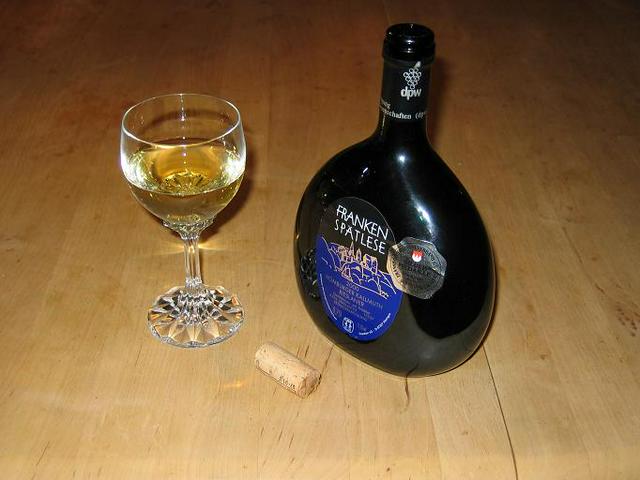 Located in a wine stronghold, wineries managed to trump the number of local beer breweries. Both wine and beer lovers, young and old alike, live and party together in harmony, as can be seen every day on the Old Main Bridge and along the Main River. Most cafés that lay along the Alte Mainbrücke allow you to drink straight from the wine glass while enjoying the fresh air outside; just don't forget to return the glass to get your hefty deposit back.
Located in a wine stronghold, wineries managed to trump the number of local beer breweries. Both wine and beer lovers, young and old alike, live and party together in harmony, as can be seen every day on the Old Main Bridge and along the Main River. Most cafés that lay along the Alte Mainbrücke allow you to drink straight from the wine glass while enjoying the fresh air outside; just don't forget to return the glass to get your hefty deposit back.
- Würzburger Hofbräu, Jägerstraße 17. The local brewery brews excellent wheat beer (Weißbier), which carries the name of a 1600s bishop of Würzburg, Julius Echter. Basically this beer is served for you in almost all the local bars, if you order a Hefe.
Würzburger Hofbräu, Jägerstraße 17. The local brewery brews excellent wheat beer (Weißbier), which carries the name of a 1600s bishop of Würzburg, Julius Echter. Basically this beer is served for you in almost all the local bars, if you order a Hefe.
Würzburg is the start of Germany's famed Romantic Road. From here you can travel down to Rothenburg and the Bavarian Alps.
- Bamberg is less than an hour away and is included on the UNESCO World Heritage List
- Veitshöchheim: Take a boat ride on the river Main to this small picturesque town that also has a Schloss with a Rococo garden. (The dock in Würzburg is beside the street Kranenkai, literally "crane dock" as there is an old crane on the boat dock.) The town is also accessible by rail.
- In Wertheim (about 35 km away), you can travel the route Charming Tauber valley from Wertheim via Tauberbischofsheim and Bad Mergentheim to Rothenburg ob der Tauber.
